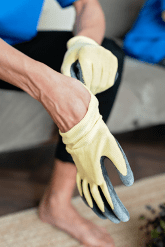All work gloves are not made the same. You need different features and durability from a pair of work gloves, depending on how often you use them and what you use them for. The gloves you use to clean or wash dishes won’t cut it in the garden, and your gardening gloves may not offer the dexterity or protection you need in the workshop.
When it comes to choosing a pair of work gloves, you should choose gloves that fit properly and have the features necessary to truly protect your hands during work. Examine gloves carefully before you buy them, to make sure they’re constructed well.
Make Sure Your Gloves Fit Properly
Your gloves should fit like they’re part of your hands. Loose gloves that slide around could make you more vulnerable to injury. Besides, it’s important to actually wear your gloves if you want to protect your hands, and you’re not going to do that if your gloves aren’t comfortable to wear and easy to put on and take off.
To make sure your gloves fit right, you should measure your hands. Measure across the width of your palm right under your knuckles, as well as the circumference of your whole hand around your knuckles. Then measure the length of your middle finger from tip to knuckle. When shopping for leather, fabric, or rubber work gloves, you will find that most glove brands offer a glove sizing chart to help you determine what size you need.
Get the Right Features for Your Job
There are so many different kinds of work gloves with different kinds of features. You can get gardening gloves with claws on them to help you dig into the soil while weeding or planting. You can get rubber cleaning gloves with long, folded cuffs that cover the forearm and protect from drips. You can buy leather work gloves with Kevlar stitching for welding work, or fabric gloves for work that requires dexterity.
You need to think carefully about what features you need in a pair of work gloves, because it will all depend on the type of job you’re doing. If you’re going to be working in the cold, you need a pair of insulated work gloves that will keep your hands warm. If you’re going to be working in the heat, you’ll need a pair of breathable gloves with a sweat-wicking feature to keep your hands cool and dry. If you need dexterity in all your fingers, choose a thinner fabric glove that fits more like a second skin. If you only need dexterity in your trigger finger (such as for hunting or operating a nail gun), choose a pair of mittens with a crab claw design that leaves the index finger able to be used separately from the other fingers. If you’re going to be working in the wet, grab gloves with rubber on the palms and fingertips – rubber gloves with a raised texture will channel water away and make it easier to grip things that are wet.
You’ll also need to choose the right cuff style. Some gloves have long cuffs that cover the wrist or even the forearms. Some have loose cuffs so that they’re easy to pull off in a hurry. Others have tight knit wrists or cinched wrists that help keep the gloves in place. Consider whether you need protection for your wrists and forearms, and how fast you’ll need to be able to remove the gloves in an emergency situation, or even whether loose gloves could get caught in machinery and become an emergency situation.
Examine Gloves Carefully Before Buying Them
Before you buy a pair of work gloves, look at them carefully to make sure they’re well-constructed. Hidden stitching and double stitching are the two most durable types. Gloves with a gunn cut, or a seam around the base of the two middle fingers, are more comfortable for longer wear. If you’re going to need a lot of grip strength, choose a glove with a straight thumb seam that runs all the way around the thumb. If dexterity and comfort are more important, choose a keystone thumb, or seam that runs around the base of the thumb. A wing thumb, in which the thumb is angled and there’s no seam between thumb and palm, is also a more comfortable choice for continuous wear.
Choosing a pair of work gloves can be complicated. Take your time when shopping for gloves, look at gloves carefully, and consider the type of job you’ll be doing with each pair of gloves. You may well need a different pair of gloves for every task, but it’s worth it to keep your hands safe and comfortable.





